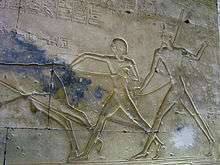Amun-her-khepeshef
Amun-her-khepeshef (died ca. 1254 BC; also Amonhirkhopshef, Amun-her-wenemef and Amun-her-khepeshef A to distinguish him from later people of the same name) was the firstborn son of Pharaoh Ramesses II and Queen Nefertari.
| Amun-her-khepeshef | ||||||
|---|---|---|---|---|---|---|
| King's Son Commander of the Troops Effective Confidant Fan-bearer on the King's Right Hand Royal Scribe | ||||||
 Prince Amun-her-kepshef (centre) at the Temple of Abydos | ||||||
| Died | ca. 1254 BC | |||||
| Burial | KV5 Thebes | |||||
| Spouse | Nefertari | |||||
| Issue | Seti (possibly) | |||||
| Egyptian name | jmn ḥr ḫpš.f | |||||
| Dynasty | 19th of Egypt | |||||
| Father | Ramesses II | |||||
| Mother | Nefertari | |||||
| Religion | Ancient Egyptian religion | |||||
- Not to be confused with Amun-her-khepeshef, a son of Ramesses III, Ramesses VI Amun-her-khepeshef and Amenherkhepshef, a son of Ramesses VI.
Name
He was born when his father was still a co-regent with Seti I. He was originally called Amun-her-wenemef ("Amun Is with His Right Arm"). He changed his name to Amun-her-khepeshef ("Amun Is with His Strong Arm") early in his father's reign.[1] He appears to have changed his name once again to Seth-her-khepeshef around Year 20 of Ramesses II.[1] Seth-her-khepeshef was formerly thought to be another son of Ramesses II.
Biography
Amun-her-khepeshef was the crown prince of Egypt for the first 25 years of Ramesses II's reign but eventually predeceased his father in Year 25 of his father's reign.[2] Ramesses B, Ramesses II's second oldest son then succeeded him as Crown Prince for another 25 years (from Year 25 to Year 50 of this pharaoh's reign). Merenptah, Ramesses II's 13th son, would later assume the throne in Year 67 of Ramesses II.
Amun-her-khepeshef, as heir to the throne, held several titles. Some of them were unique such as "Commander of the Troops", "Effective Confidant" and "Eldest Son of the King of his Body." Some of his other titles were shared with other prominent princes such as "Fan-bearer on the King's Right Hand" and "Royal Scribe". His titles indicate that he held a high position in the army, and according to some relief depictions, he and his younger half-brother Khaemwaset fought in the Battle of Kadesh and the campaigns in Nubia (or at least he accompanied his father to these battles). He appears on a wall in the Temple of Beit el-Wali. Amun-her-khepeshef was involved in an exchange of diplomatic correspondence with the Hittites after Ramesses II's Year 21 peace treaty with them.[1]
Statues and depictions of Amun-her-khepeshef appear in his father's famous temples in Abu Simbel, Luxor, in the Ramesseum, and in Seti's Abydos temple. He is depicted with his father lassoing a bull in the Abydos temple walls and appears frequently on Ramesses II's statues.[1]
Death
Amun-her-khepeshef died around Year 25 of his father's reign.[3] He is known to have had a wife named Nefertari – who could be identical with Ramesses' daughter, Nefertari, possibly a child of Queen Nefertari[2] – and a son named Seti. The next crown prince was his half-brother Ramesses, the eldest son of Queen Isetnofret. Amun-her-khepeshef was buried in tomb KV5 in the Valley of the Kings, in a large tomb built for the sons of Ramesses II. His interment was apparently inspected in Year 53 of Ramesses II.[1]
Among the artefacts found in the tomb were canopic jars labeled with Amun-her-khepeshef's name and containing organs. Also found were bones from four males including a skull with a deep fracture, believed to have been made by a mace.[4]
Amun-her-khepeshef's father, Ramesses II, is one of the more popular candidates postulated to be the Pharaoh of The Exodus in the Bible. Adherents to that theory believe that Amun-her-khepeshef was the firstborn son of the pharaoh described in the book of Exodus as being killed in the final biblical plague in Egypt.[4][5]
References
- Aidan Dodson & Dyan Hilton, The Complete Royal Families of Ancient Egypt, Thames & Hudson (2004), p.170
- Dodson & Hilton, p.173
- "Anneke Bart: Ramesses II". Archived from the original on 2008-07-24. Retrieved 2006-11-06.
- Boyle, Alan (12 January 2004). "A Pharaoh's firstborn son is resurrected". NBC News. Retrieved 17 September 2015.
- "In Discovery Channel's RAMESES: WRATH OF GOD OR MAN?, a Find in a Massive Tomb Could Be a Crown Prince Who Provides Ties to the Story of Exodus". PR Newswire. Retrieved 16 September 2015.
| Wikimedia Commons has media related to Amun-her-khepeshef. |